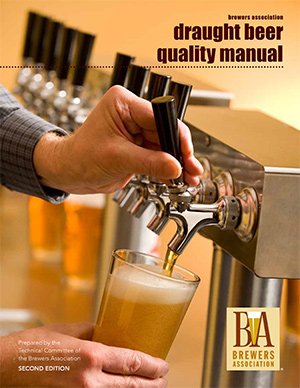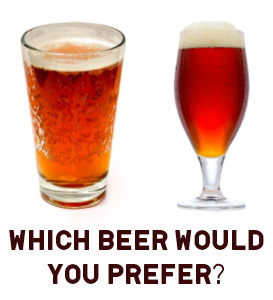Appreciation of any food or beverage should be free from detergent (yikes!), food residue (yeesh!), oils (ugh!), lipstick (ew!) and other unseemly sensory assaults. No-brainer, right? However, dirty glassware is a plague that haunts both at home and in out-of-touch dining establishments.
It’s great that we are finally getting the culinary world to pour beer into an actual glass—thank goodness—but now we have the issue of remnant-riddled glassware.
Dishes, cutlery and glassware sometimes have residue that we, the thirsty and hungry innocent, simply cannot see. So, here’s the trick to immediately know if you’re dealing with dirty glassware: look for carbonation bubbles on the inside of your glass. Beer’s carbonation colonizes on the what should be forbidden funk clinging to the interior of any beer vessel.
With the exception of laser-etched glassware, clean glass should be smooth enough to leave none of the irregularities on which bubbles like to form. When bubbles cling to the sides of your beer glass, it is a huge red flag signaling that residual food and often soap (yuck!) is present in your beer and entering your body.
If only it was that easy to tell what still lingers on our plates while we eat.
“Beer lovers should not be forced to consume the evidence of any vessel’s previous affairs, no matter how intimate we like to get with our craft beer.”
Carbonation
Yes my friends, carbonation is one mighty and magical ingredient in beer. Besides calling attention to foreign matter that did not come from the brewer or beer, carbonation also:
- Produces that aroma-enhancing collar of foam
- Livens up a beer’s mouthfeel
- Dries out a beer’s finish as a flavor balancing element
- Scrubs the tongue, preparing it for the next bite of food or sip of beer
So if you see bubbles clinging to the inside of your glass, send it back to the manager for more cleaning. Beer lovers should not be forced to consume the evidence of any vessel’s previous affairs, no matter how intimate we like to get with our craft beer. You can quote me on that.
Industry Insiders on Dirty Glassware
Here is what some in the craft brewing community had to say on the topic of dirty glassware:
Claudia Faulk | Partner/CFO/Chief glass washer Aztec Brewing CompanyOpens in new window | Vista, CA
I was just served a nitro stout with bubbles lining the entire side of the glass. These bubbles were forming on contaminants. First, residue muddles the flavor of the beer. Who knows how it alters the taste? If I’m serving beer I am proud of, I want people to taste that specific beer. Dirty growlers that have been stored with the cap on are scary too. You open them up and they go poof. I keep waiting for a dirty anti-beer genie to come out. Rinse them out when you are done.
Tom Schaeffer | CEO Black Cloister Brewing Company | Toledo, OH
There is nothing quite as disappointing as ordering at a bar that features craft beer and receiving it in dirty glassware. When you lift the beer to your nose and just smell chemicals, or visually have a beer that has a quickly dissipating head, it greatly detracts from the entire drinking experience. It does the brewer a great disservice.
Know the bar and the staff. You can certainly request for your glass to be rinsed, or complain about it not being beer clean. I’ve done it many times — usually I’m just seen as a snob. But, if I know the bar and the staff, then they know me. In those situations, rarely do I receive a glass that is not beer clean, and, when I do, the relationship is there that they replace it without question.
Mike V. Sardina | Rule of the Underworld (assistant executive officer) Societe Brewing CompanyOpens in new window | San Diego, CA
Brewing and packaging beer is all about cleanliness and sanitation in the brewery. We literally spend our working days cleaning, whether that be cleaning the brewhouse, sanitizing fermentors, prepping bright tanks, or sanitizing or sterilizing hoses, clamps, valves and kegs. Why should the attention to cleanliness stop once the brewing is finished?
A beer-clean glass is the only way to properly respect beer that is born from clean practices and processes. A clean glass ensures that the sight, aroma and taste of the beer is exactly what our brewers intended it to be. You don’t see a world-class chef allow their meals to be served on a dirty plate, so why should a brewer allow their beer to be served in a dirty glass?
Just like cleaning in the brewery, you need to take the time to clean glassware properly. Be sure to teach those folks who serve your beer how to properly wash glasses, either manually or with an automatic washing machine. Be sure to use the correct detergents and sanitizers. Once the glass is clean, be sure to handle clean glassware properly. And finally, make sure that you are periodically testing for beer-clean glassware.
Put Your Glassware to the Test
 Whether you’re serving beer professionally or at home, it’s easy to check that your glasses are properly clean. Here are the three methods outlined in the Brewers Association Draught Beer Quality Manual (page 48):
Whether you’re serving beer professionally or at home, it’s easy to check that your glasses are properly clean. Here are the three methods outlined in the Brewers Association Draught Beer Quality Manual (page 48):
- Sheeting Test: Dip the glass in water. If the glass is clean, water evenly coats the glass when lifted out of the water. If the glass still has an invisible film, water will break up into droplets on the inside surface.
- Salt Test: Salt sprinkled on the interior of a wet glass will adhere evenly to the clean surface, but will not adhere to the parts that still contain a greasy film. Poorly cleaned glasses show an uneven distribution of salt.
- Lacing Test: Fill the glass with beer. If the glass is clean, foam will adhere to the inside of the glass in parallel rings after each sip, forming a lacing pattern. If not properly cleaned, foam will adhere in a random pattern, or may not adhere at all.
For more information on beer-clean glassware, visit DraughtQuality.org and download a copy of the Brewers Association Draught Beer Quality Manual.
CraftBeer.com is fully dedicated to small and independent U.S. breweries. We are published by the Brewers Association, the not-for-profit trade group dedicated to promoting and protecting America’s small and independent craft brewers. Stories and opinions shared on CraftBeer.com do not imply endorsement by or positions taken by the Brewers Association or its members.


Share Post